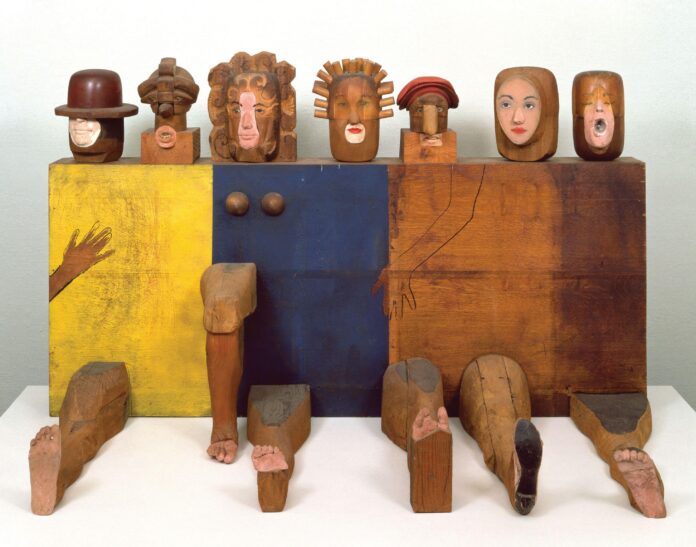Marisol Escobar (1930-2016), the Paris-born, Venezuelan American artist who went by her first name and became one of the most famous figures of the US Pop art movement in the 1960s, continued making work for a half-century that complicated the categorisation of her art and anticipated the more overtly political and identity-based work that emerged in Pop’s wake.
Now, a major travelling retrospective, which opens at the Montreal Museum of Fine Arts on 7 October, will offer the fullest picture to date of Marisol’s life and work across more than 150 works and a range of ephemera.
The show has been organised by the Buffalo AKG Art Museum in western New York state, which was the first institution to acquire Marisol’s work, in 1962, and to which she bequeathed her estate upon her death. The exhibition will travel to Buffalo next summer after a stint at the Toledo Museum of Art before ending its tour at the Dallas Museum of Art in 2025. For many viewers, one of its revelations will be just how famous the artist was in the 1960s—and then how completely she fell out of the spotlight.

Now you see me, now you don’t: the photographer Hans Namuth’s 1964 portrait of Marisol, when her fame extended beyond the art world © Hans Namuth Estate, Center for Creative Photography and Estate of Marisol/Buffalo AKG Art Museum/ARS
“Her celebrity far exceeded that of the art world—she wasn’t just on the covers or in the pages of art magazines, she was in women’s magazines and fashion magazines,” says Cathleen Chaffee, the chief curator at the Buffalo AKG Art Museum and curator of the exhibition. “She was a massive celebrity for ten years and then most people don’t know what she did after.”
The exhibition, proceeding both chronologically and thematically, will gather her early work of the 1950s, her best-known totemic and mixed-media sculptures of the 1960s, look at the more overtly political topics that dominated her work in the 1970s, explore her collaborations with performing artists, and public monument commissions. Through it all and until her final years, Marisol continued to draw—psychedelically hued images often bordering on the mystical, their hybrid or monstrous figures frequently incorporating tracings of her own body—and many works on paper from her Buffalo bequest will be featured throughout.
“There is a fascinating consistency in the subjects she’s thinking about in her drawings, in the ways that she’s approaching the human body and critically approaching the way women’s bodies meet the world,” Chaffee says. “So much of the subversive quality of her work is more easily read in her works on paper than in her sculpture, although it is present there.”

An untitled drawing by Marisol from around 1958-59 made using coloured pencil, crayon and collage on paper Collection Buffalo AKG Art Museum © Estate of Marisol / ARS, New York
In addition to the drawings, ephemera and sculptures from Marisol’s bequest—which account for the majority of the material in the exhibition—more than a dozen of her most famous works from the 1960s will be coming on loan. Among these are her sculptural portrait of fellow Pop art star Andy Warhol (1962-63) from the Guggenheim Abu Dhabi and her famous assemblage of 15 life-sized figures, The Party (1965-66), from the Toledo Museum of Art.
“The signature characteristic of her sculpture is the combination of four elements—carved forms, drawn forms, cast forms and found or readymade elements—which is why her work is instantly recognisable at 100 yards,” Chaffee says. “Nobody else ever made sculptures that combined those forms.”
Two other quintessential Marisol sculptures from this era, Baby Boy (1962-63) and Baby Girl (1963), will be reunited for the first time since their debut at New York’s Sidney Janis Gallery in 1964. With their boxy torsos, drawn-on faces, cast body parts, found objects and collaged elements, they epitomise the artist’s approach to sculpture, while also crystallising core themes in her work, from feminist concerns about the social and physical constraints forced upon girls and women to Cold War-era critiques about American exceptionalism and interventionism.

Marisol’s mixed-media Baby Girl (1963), one of a pair of sculptures that embodied recurring themes in the artist’s work around the representation of women and of American exceptionalism during the Cold War era © Estate of Marisol/ARS
“Their messages are instantly intelligible, even if you don’t know about the nuclear giants [of Cold War science-fiction films], babies are physically tiny but they take up a lot of air in the room, they take over people’s lives—all that they require is so huge,” says Delia Solomons, an art historian at Drexel University in Philadelphia who contributed an essay to the exhibition catalogue about resonances between Marisol’s work and contemporaneous popular culture. “In Baby Boy, specifically, she’s showing the US as this immature, towering, ferocious monster holding someone—specifically Marisol—in his grasp.”
As the exhibition aims to make clear, Marisol’s own image remained firmly in her grasp. Even at the height of her celebrity, she complicated the expectations placed upon her—as a Latin American woman (she represented Venezuela at the Venice Biennale in 1968), as an environmentalist and critic of American politics, as someone who was famously spare with her words. “Her supposed silence that achieved this mystic status was really a way of curtailing reductive readings of her work,” Solomons says.
• Marisol: A Retrospective, Montreal Museum of Fine Arts, 7 October-21 January 2024; Toledo Museum of Art, March-June 2024; Buffalo AKG Art Museum, July 2024-January 2025; Dallas Museum of Art, February-July 2025

























